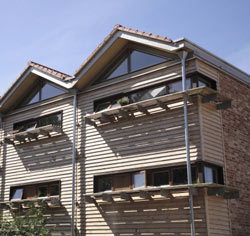We are the UK Government’s independent adviser on sustainable development. Through advocacy, advice and
appraisal, we help put sustainable development at the heart of Government policy
Built Environment

Creating a sustainable built environment, through design, construction and management, enables all people to live well, within environmental limits. Our built environment should inspire us and make us feel proud of our local areas and diverse heritage. It should reduce whole life carbon and materials costs through efficient use of resources (energy, waste, water). It should provide environments that contribute to our physical and mental health and enhance creativity and productivity. Our built environment also needs to be flexible and adaptable to future uses, and be resilient to cope with local effects of climate change.
Construction is one of the UK’s leading industries. It employs over 2 million people, so moving it towards sustainable operations offers huge opportunities for upskilling the workforce and will have a major impact on our ability to achieve a sustainable future.
Whilst new built environments strive to meet these aspirations we must not forget the legacy of our existing buildings and infrastructure, constructed when standards for efficiency were much lower. For example, at least 80% of our current housing stock will still be standing in 2050. This means that requirements for retrofitting to tackle resource efficiency are vitally important.
Enabling communities to lead local renewal projects with a neighbourhood-scale approach is the most cost-effective way to ensure our villages, towns and cities are fit for the future and create the conditions for people to thrive. Through empowering community groups to come together to tackle issues of local priority, and to work in partnership with local authorities and businesses, multiple benefits can be delivered. Such upgrades to our physical infrastructure not only tackle climate change, they can also deliver reliable and efficient transport networks, improve health and well being, secure a healthy natural environment, improve long-term housing supply, maximise employment opportunities, and make our communities safer and more cohesive.
Wales
In Wales, the SDC has taken a central role in helping to achieve a low carbon built environment. In November 2008 the SDC launched a groundbreaking Green Building Charter in conjunction with WAG and the Design Commission For Wales. Over 50 organisations have signed up to support progress towards low or zero carbon buildings. To co-ordinate the work of the signatories, the SDC supported the formation of the Wales Low/Zero Carbon Hub – a partnership of public, private and voluntary sectors.
Scotland
SDC Scotland has had a central role in creating better planning policy in Scotland. The Scottish National Planning Framework 2 integrates sustainable development principles in planning processes. It provides a valuable instrument in making planning outcomes in Scotland more sustainable but there is much work to be done to integrate the sustainable development principles into all local planning decisions.
Key Publications
» Building Houses or Creating Communities?
» Stock Take: Delivering improvements in existing housing
» The Future is Local: Empowering communities to improve their neighbourhoods
» Carbon Emissions from Schools: Where they arise and how to reduce them
» Review of opportunities for improved carbon savings from spend on education buildings
» Sustainable Buildings - The Challenge of Existing Stock
» Sustainable development and UK faith groups: Two sides of the same coin?
